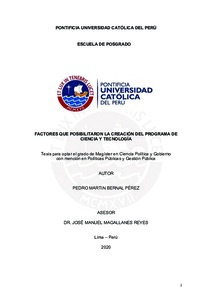| dc.contributor.advisor | Magallanes Reyes, José Manuel | |
| dc.contributor.author | Bernal Pérez, Pedro Martin | |
| dc.date.accessioned | 2020-07-28T03:17:15Z | |
| dc.date.available | 2020-07-28T03:17:15Z | |
| dc.date.created | 2020 | |
| dc.date.issued | 2020-07-27 | |
| dc.identifier.uri | http://hdl.handle.net/20.500.12404/16722 | |
| dc.description.abstract | El presente estudio de caso propone identificar, a partir de metodologías
cualitativas, los factores que posibilitaron la creación del Programa de Ciencia y
Tecnología creado el año 2006 mediante contrato de préstamo entre el gobierno
del Perú y el Banco Interamericano de Desarrollo (BID) Esta metodología implicó
la definición de un marco analítico para el análisis de los procesos decisionales
de política pública, la entrevista a actores gubernamentales y no
gubernamentales que formaron parte del proceso de creación del programa, así
como la revisión de fuentes secundarias relacionada a los aspectos
administrativos y legales de su creación. Posteriormente se procedió a
reconstruir el proceso decisional de creación del Programa de Ciencia y
Tecnología, analizar a los actores que formaron parte poniendo énfasis en sus
objetivos, intereses, recursos y roles, analizar las interacciones y estrategias
utilizadas y describir el contexto decisional que enmarcó el accionar de los
involucrados. Los resultados permiten evidenciar que la creación del Programa
de Ciencia y Tecnología resultó estar lejos de ser un proceso puramente técnico,
en el que, los actores involucrados definían de la manera más racional posible,
los contenidos del programa, por el contrario, se evidencia que su creación y
definición de contenidos estuvo delimitada por las interacciones y estrategias
motivadas por los intereses de los actores involucrados. Estas interacciones y
empleo de estrategias se dieron en dos etapas, la primera comprendió el periodo
1994 - 2000, y la segunda, el periodo 2001 - 2006. Se destaca además la
participación del BID que, por medio de recursos cognitivos y económicos y
asumiendo el rol de promotor, aliado y experto técnico, dependiendo de la etapa
del proceso decisional, contribuyó notablemente con la creación del programa.
Así mismo, se evidencia que un contexto económico de crecimiento y una
situación de superávit fue favorable para que se tomará la decisión de aprobar
la creación del Programa de Ciencia y Tecnología. | es_ES |
| dc.description.abstract | The present case study aims to identify the factors that led to the creation of the
Science and Technology Program created by the loan agreement between the
Government of Peru and the IDB the year 2006, on the basis of qualitative
methodologies. This methodology involved the definition of an analytical
framework for the analysis of decision-making processes of public policy, the
interview with governmental and non-governmental actors who formed part of the
process of creation of the program, as well as the review of secondary sources
related to the administrative and legal aspects. It was subsequently proceeded to
reconstruct the process of creation of the Science and Technology Program,
analyse the actors who formed part with an emphasis on their objectives,
interests, resources and roles, analyse the interactions and strategies used, and
describe the decision context that framed the actions of those involved. The
results allow us to demonstrate that the creation of the Science and Technology
Program turned out to be far from being a purely technical process in which the
actors involved defining, in the most rational way possible, the contents of the
Program, on the contrary, there is evidence that its creation and definition of its
content was delimited by the interactions and strategies driven by the interests of
the actors involved. These interactions and employment of strategies occurred in
two stages. The first covered the period 1994 - 2000, and the second the period
2001 - 2006. Further stresses the participation of the IDB, through cognitive
resources and funding, and assuming the role of promoter, who is an ally and
technical expert, depending on the stage of the decision-making process,
contributed significantly to the creation of the program. At the same time, there is
evidence that an economic context of growth and a surplus, was favorable for the
decision to approve the creation of the Program. | es_ES |
| dc.language.iso | spa | es_ES |
| dc.publisher | Pontificia Universidad Católica del Perú | es_ES |
| dc.rights | info:eu-repo/semantics/openAccess | es_ES |
| dc.rights.uri | http://creativecommons.org/licenses/by-nc/2.5/pe/ | * |
| dc.subject | Banco Interamericano de Desarrollo | es_ES |
| dc.subject | Asistencia técnica--Perú | es_ES |
| dc.subject | Ciencia y Estado--Perú | es_ES |
| dc.title | Factores que posibilitaron la creación del Programa de Ciencia y Tecnología | es_ES |
| dc.type | info:eu-repo/semantics/masterThesis | es_ES |
| thesis.degree.name | Magíster en Ciencia Política y Gobierno con mención en Políticas Públicas y Gestión Pública | es_ES |
| thesis.degree.level | Maestría | es_ES |
| thesis.degree.grantor | Pontificia Universidad Católica del Perú. Escuela de Posgrado | es_ES |
| thesis.degree.discipline | Ciencia Política y Gobierno con mención en Políticas Públicas y Gestión Pública | es_ES |
| renati.advisor.orcid | https://orcid.org/0000-0002-2593-0859 | es_ES |
| renati.discipline | 312167 | es_ES |
| renati.level | https://purl.org/pe-repo/renati/level#maestro | es_ES |
| renati.type | http://purl.org/pe-repo/renati/type#tesis | es_ES |
| dc.publisher.country | PE | es_ES |
| dc.subject.ocde | https://purl.org/pe-repo/ocde/ford#5.06.00 | es_ES |






